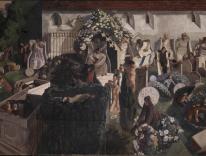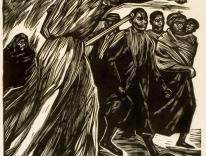
A man undergoing a midlife crisis buys a sports car. At least that’s the cliché I remember from the nineties. Perhaps the anxious men of today buy pickup trucks or, if they listen to podcasts, cryptocurrencies—unless such men have lost their jobs, which is not unlikely. In that case, maybe they pull a Walter White and earn some extra cash moving narcotics. Everyone has a side hustle nowadays.
But what does a woman buy when she’s the one having a midlife crisis? I don’t mean to engage in some hack stand-up routine. Assumptions about what men and women in this stage of life desire can illuminate much about prevalent attitudes regarding sex, gender, and aging. Perhaps this hypothetical woman doesn’t buy anything; perhaps, like Madame Bovary or Anna Karenina, she engages in an affair, the love of a younger man rekindling her own youthful spirit.
A doomed love affair, though, sounds very nineteenth century. Today, the average educated woman gets married later in life, and she may not pine for romance as much as a windswept heroine on the Highland moors. She probably works too, and between working out at the gym and performing the lion’s share of household chores, likely does not have many occasions for her bosom to heave in the presence of a rugged farmhand.
Allow me, then, to venture a guess. A woman of the twenty-first century, weathering a midlife crisis, will find herself in want of a house. There are now whole industries catering to women’s ongoing love affair with real estate: Boomer women, endowed with their retirement savings, watch HGTV and select the perfect backsplash for the kitchen sink; their frugal Millennial daughters, navigating the post-2008 economy, browse Zillow looking for deals on turn-of-the-century homes with good bones. Meghan Daum, working between these generations as a member of Gen X, neatly summarized this impulse with the title of her 2010 memoir: Life Would Be Perfect If I Lived in That House.
Wayward, Dana Spiotta’s new novel, dramatizes just such a relationship between a middle-aged woman and her dream home. But while there is certainly humor in Wayward, the approach is darker and more obsessive than one might assume, given the subject matter. The dreams that the dream house affords become quite unsettling.
The story finds Sam Raymond turning fifty-three in the year 2017. Her life is comfortable. Her husband, Matt, is a successful lawyer. Their seventeen-year-old daughter, Ally, is a driven, successful student, fond of looking up Latin etymologies on her phone. The family lives in a comfortable house in a suburb of Syracuse, New York. In between working out at the gym and buying salmon at the grocery store, Sam works a part-time job at the Clara Loomis House. Loomis, a real historical figure, briefly lived in the town’s Oneida Community, and she went on to write pamphlets in support of birth control and the suffragette movement.
One day, Sam comes across a beautiful old Arts and Crafts home in a rundown neighborhood of Syracuse. The listed price is $38,000, a steal. But the house would need to be completely redone, from floor to ceiling—the kind of job that would require money, time, and the hiring of skilled labor. Sam does something impulsive: she buys the house without telling her husband. Then she does something even more impulsive: she tells her husband that she wants a divorce. She will leave their suburban home and move into the falling-apart house, where she will live, alone.
Why does she want to leave her family? Does she still love them? She loves her daughter, yes. Ally looms large in her life, the locus of many of Sam’s hopes and fears. As for Matt, her husband, well—she may not love him, not at the moment, but she doesn’t hate him either. The source of her unease, and her need to claim the house as entirely her own, comes from somewhere deeper, a place Sam herself can’t easily access. Matt believes the recent inauguration of Donald Trump is what’s driving her to such rash action. She’s angry, understandably so, and this is the outlet her anger finds. Sam, of course, hates such a pat explanation. There is a political element to her anger, but there’s also much more at work. She is angry at life! At growing old! At a society that expects women to accept invisibility with a smile and a nod!
As Sam begins her solitary existence in her empty home, timely subject matter keeps intruding upon her life. Flush with formless rage from the inauguration, she attends a Resistance meeting populated by her fellow demographic cohorts, upper-middle-class white women. While Sam agrees with their politics, she finds their earnestness cloying. Soon, via private Facebook groups, she meets up with more strident groups of women who devote their energies to subverting the impossible beauty expectations of a patriarchal society.
The passages about Facebook brought to mind two recent novels: Lauren Oyler’s Fake Accounts and Patricia Lockwood’s No One Is Talking About This. The authors, both white Millennial women, have been praised for capturing “the internet,” when what they really capture is Twitter. Media outlets have a habit of treating Twitter as a synecdoche for the internet as a whole. After all, it’s the native habitat for toxic swamp creatures—journalists, politicos, and their ilk. But Spiotta, a Gen X author, turns her attention to dowdy old Facebook, suggesting that the disdain the Extremely Online lay at the base of Mount Zuckerberg replicates the generational divides that often mar feminist causes today.
Further trending topics accrue. Ally pursues a clandestine affair with an older man. Sam witnesses an act of police violence. The latter especially feels shoehorned into the story, a grasp at relevance. But as the novel’s closing section demonstrates, Wayward’s concerns are more timeless than we’ve been led to expect.
Lily, Sam’s mother, has been diagnosed with inoperable cancer. She’d told this to Sam well before the events of the story had begun, but Sam hasn’t been able to voice the situation to herself, let alone anyone else. Buying the house, and blowing up her life, are a means of evading the grief that is sure to come, and the concomitant reminder of her own mortality. But rather than escape the past, the house brings Sam face to face with it.
One night, alone in her lonesome house, Sam collapses. She hits her head on one of the beautiful tiles that she so admired, and begins bleeding on the hardwood floors. But her blood, like some newfangled caulking agent, connects her to the house. She has a vision of herself. She sees the past, in the form of Clara Loomis, the nineteenth-century feminist whose legacy she stewards. She sees the future, and how it will go on without her. Rather than serve as the capstone of a perfect life, the falling-down house acts as a bridge to the larger forces of time, life, and existence. The vision allows Sam to accept the losses that her life will surely entail.
Wayward is a haunted-house story in reverse: the story of a ghost who enters an empty house, and comes back to life.
Wayward
A Novel
Dana Spiotta
Knopf
$27 | 288 pp.


